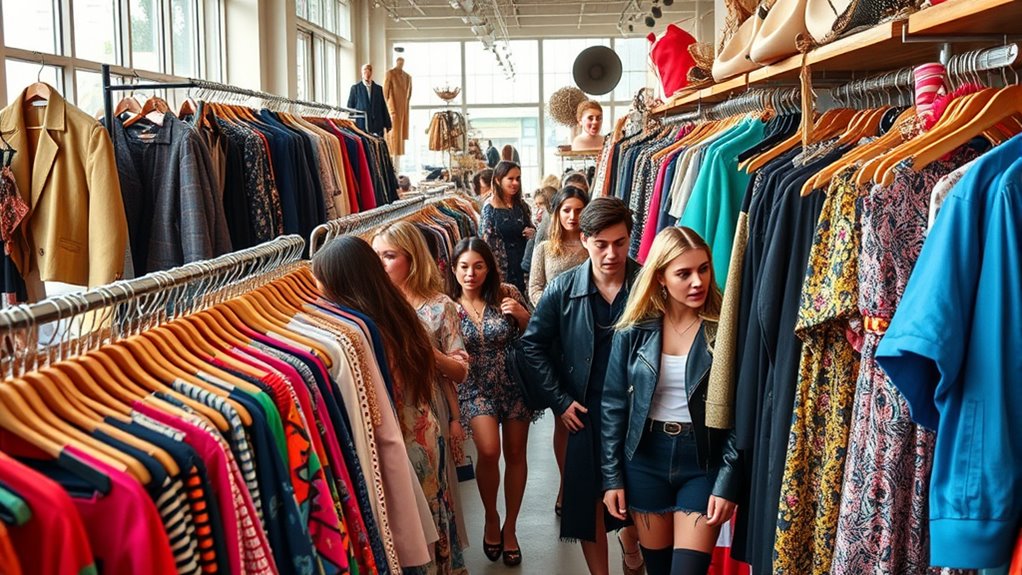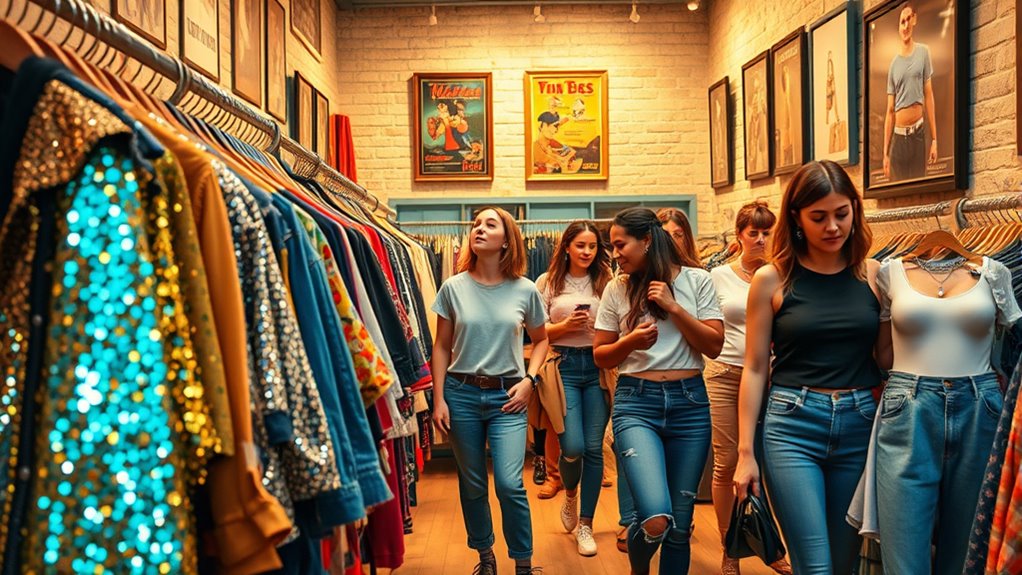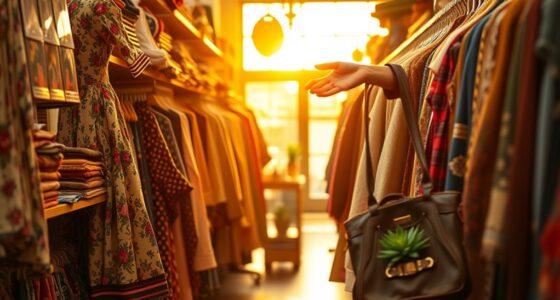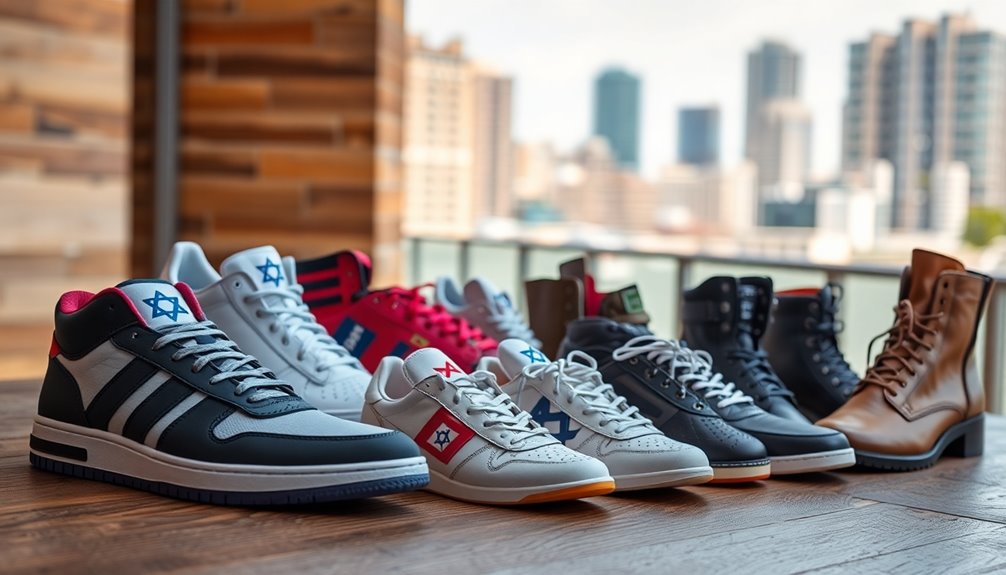The resale revolution has turned thrifting into a high-fashion movement by emphasizing sustainability, unique vintage finds, and designer pieces. Online platforms make it easy to access curated collections and authentic luxury items, changing how you see secondhand shopping. It’s no longer just budget-friendly—it’s a way to express individuality and support eco-conscious choices. If you keep exploring, you’ll discover how this trend is shaping the future of fashion and personal style.
Key Takeaways
- Resale emphasizes sustainability and vintage trends, transforming thrifting into a fashionable, eco-conscious lifestyle choice.
- Social media influencers and collaborations boost thrifted items’ status, elevating them to high fashion.
- Online platforms make designer secondhand pieces accessible, authenticating luxury thrift finds globally.
- Vintage shopping shifts perceptions of luxury, highlighting quality, history, and unique style over fast fashion.
- The resale movement promotes responsible consumerism, blending sustainability with personalized, statement-making fashion.

Have you noticed how the resale market is transforming the way we buy and sell? It’s no longer just about clearing out clutter or finding a bargain; it’s become a movement rooted in sustainable shopping and vintage trends. More people are turning to thrift stores, online marketplaces, and consignment shops to find unique pieces that stand out from mass-produced fashion. This shift isn’t just a fleeting trend—it’s reshaping the fashion industry and redefining what it means to be stylish.
When you embrace resale, you participate in sustainable shopping that minimizes waste and reduces the environmental impact of fast fashion. Buying secondhand means fewer new garments are produced, less water is used, and less textile waste ends up in landfills. It’s a conscious choice that aligns with growing awareness about environmental issues and the need to make fashion more responsible. As consumers become more eco-conscious, vintage trends have gained popularity, fueling a desire for authentic, one-of-a-kind items that tell a story. You’re not just purchasing clothing; you’re investing in pieces that carry history and character, often at a fraction of the original price.
Embrace secondhand shopping to reduce waste, support responsible fashion, and discover unique, story-rich pieces at great prices.
The rise of vintage trends has also shifted the perception of what high fashion looks like. Thrifting and resale shops are now seen as treasure troves of designer labels, rare finds, and timeless classics. Many influencers and fashion icons showcase their thrifted outfits on social media, proving that looking stylish doesn’t have to mean buying new. This has led to a new appreciation for curated vintage collections and a focus on quality over quantity. You might find yourself hunting for that perfect 90s jacket, a vintage handbag, or a pair of retro sneakers that elevate your personal style without breaking the bank.
Furthermore, the resale market’s accessibility has exploded thanks to online platforms that connect buyers and sellers across the globe. Apps and websites make it easier than ever to browse curated collections, authenticate designer pieces, and resell items with confidence. This convenience encourages you to extend the lifespan of clothing items, making sustainable shopping more practical and appealing. As resale becomes mainstream, it’s normal to see high-end fashion brands collaborating with vintage shops or launching their own resale initiatives, reinforcing that secondhand is now a symbol of style and sustainability. Additionally, understanding the importance of contrast ratio can help you choose projectors that deliver vibrant images, much like selecting the right vintage pieces enhances your style.
In embracing this resale revolution, you’re helping to redefine fashion’s future—one where sustainability, individuality, and vintage trends are at the forefront. It’s an exciting time where thrifting isn’t just a cost-saving habit but a statement of conscious consumerism and fashion innovation.
Frequently Asked Questions
How Does Thrifting Impact Traditional Luxury Brands?
Thrifting impacts luxury brands by shifting consumer perception and increasing demand for sustainable, affordable fashion options. You might see more people choosing secondhand items over new luxury pieces, which challenges traditional luxury brand impact. As you embrace thrifting, you influence how brands market themselves, encouraging them to focus on authenticity and sustainability. This trend pushes luxury brands to innovate, adapt, and rethink their strategies to stay relevant in a changing market.
What Are the Environmental Benefits of Thrifting?
Imagine a greener planet—thrifting makes that possible. By choosing sustainable fashion and eco-friendly shopping, you reduce waste and lower demand for new resources. Every item you buy secondhand extends its life, cuts carbon emissions, and conserves water. This simple act of thrifting helps combat pollution and preserves ecosystems, turning your fashion choices into a powerful force for environmental change. It’s a stylish way to help the Earth thrive.
How Can Beginners Start Thrifting for High Fashion?
You can start thrifting for high fashion by exploring local thrift stores and online marketplaces. Look for vintage finds that stand out and match your style. Use styling tips like mixing vintage pieces with modern items to create unique outfits. Don’t be afraid to try different sizes and brands, and always check for quality. With patience and curiosity, you’ll discover hidden gems that elevate your wardrobe effortlessly.
What Are the Most Popular Resale Platforms Today?
Imagine a treasure trove at your fingertips—these platforms are bursting with vintage finds and sustainable shopping options. You’ll want to check out Depop, where unique pieces reign supreme, or ThredUp, perfect for eco-conscious shoppers. Grailed offers high-end vintage finds, while Poshmark makes reselling a social experience. These sites are the top choices today, making it easy for you to score stylish, sustainable pieces and join the resale revolution.
How Do Resale Prices Compare to Original Retail Prices?
You’ll notice resale prices often fluctuate due to demand, rarity, and seasonality, making resale value unpredictable. Sometimes, you can score deals below retail, especially when prices drop during slow demand. Other times, popular items hold or even surpass their original retail prices because of limited availability. These price fluctuations mean you should act quickly for the best resale value, but don’t expect consistent savings every time.
Conclusion
Now that you see how thrifting has transformed into high fashion, it’s clear the resale revolution is here to stay. With sustainable choices, unique finds, and designer deals, why wouldn’t you join the movement? Embracing thrift isn’t just a trend—it’s a statement. So, are you ready to redefine your style and make a positive impact on the planet? The future of fashion is in your hands—are you in?









